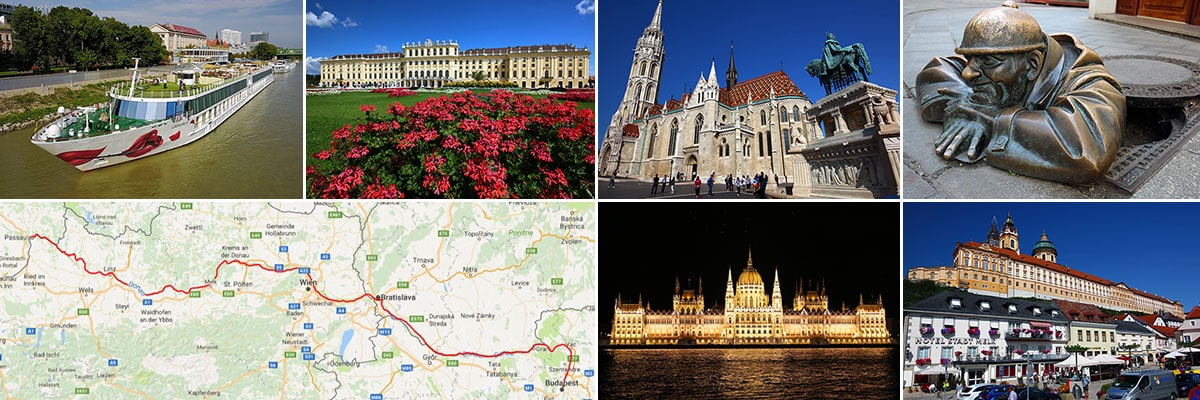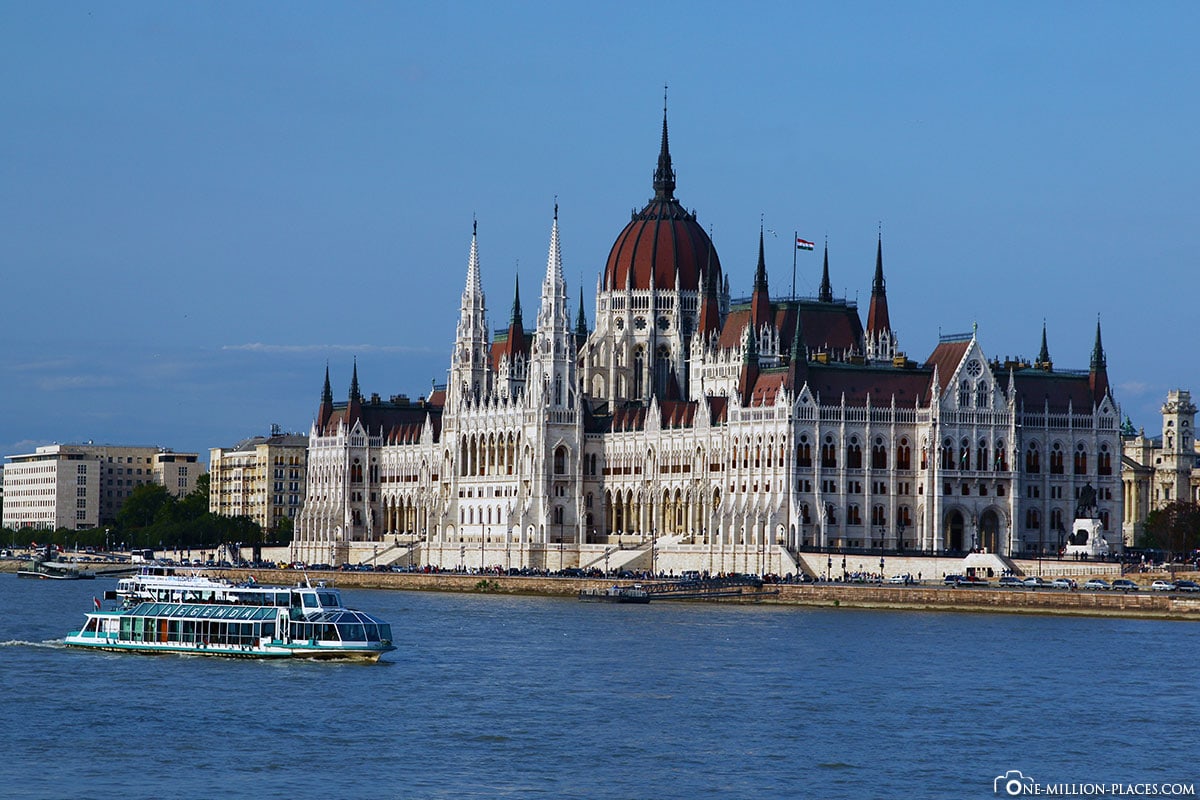After looking at the sights of Budapest on the Buda side (Castle Palace, Matthias Church, Fisherman’s Bastion) this morning, we were told to explore the main attractions of the Pest side.

Table of contents
The Market Hall of Budapest
In the early morning we had already looked at the market hall of Budapest, as it is only a 5 minute walk from our ship on the Pest side. The Market Hall (Nagy Véscisarnok) is modelled on a basilica and is considered one of the city’s landmarks. On three floors, more than 180 market stalls line up, where you can find all sorts of goodies: from fruits and vegetables to meat and fish to souvenirs and textiles – the offer is very large. Nevertheless, we were a little disappointed with the market hall, because in the morning we lacked the typical “market drive” and actually there was relatively little going on. We couldn’t see anything special about the market hall.
The Hungarian Parliament
Definitely the highlight on the Pest side is the richly decorated, colossal Hungarian Parliament directly on the banks of the Danube. With a length of 268 meters, a width of 123 meters and a dome height of 96 meters, it looks very powerful. It is hard to believe that the building houses almost 700 rooms, 10 courtyards and 365 turrets. The parliament was built at the end of the 19th century and was completed in 1904. A total of 1,000 workers were involved in the construction, more than 40 million stones were stacked on top of each other and 40 kilograms of gold were used. The dimensions of this building are truly incredible. It is worth notonly a view of Parliament from the banks of the Danube, but also from the back. Here you will find a small park and two statues. At the nearby Martyrs’ Square, a statue of former Prime Minister Imre Nagy stands on a bridge and looks towards Parliament.
The Holocaust Memorial & Freedom Square
About 300 meters in a southerly direction you can see sixty pairs of metal shoesthat stand on a length of 40 meters directly on the promenade on the banks of the Danube. The Holocaust Memorial was erected in 2005 in memory of the Hungarian Jews, who were innocently shot by Arrow Crusaders in 1944 and 1945 and then thrown into the Danube.
On the way to the great St. Stephen’s Basilica you pass freedom square, which was opened up at the end of the 19th century. The square is framed by some important buildings, such as the former stock exchange and the Hungarian National Bank. In the middle of Freedom Square is a Soviet monument honoring the Soldiers of the Red Army who died in 1944 and 1945 during the liberation of Budapest. In addition, a bronze statue of former Us President Ronald Reagan was erected on the square in 2011 in recognition of his help in ending the Cold War.
St. Stephen’s Basilica
On foot we went on to St. Stephen’s Basilica, which is dedicated to the first Hungarian King Stephen. The neoclassical church was built between 1851 and 1905. In 1868, the 96-metre-high dome collapsed due to faulty foundations and destroyed the then half-finished structure. The basilica can accommodate up to 8,500 people and today houses many stained glass, paintings and sculptures. A relic kept in the chapel of St. Leopold is the embedded right hand of King Stephen (“Holy Rights”). We found this a bit bizarre, considering that King Stephen lived in the years 969 to 1,038 – so the hand is about 1,000 years old!
Heroes’ Square with the Millennium Column
From here we went by subway M1 to the well-known Heroes’ Square. A ride on line M1 of the Budapest Metro is truly an experience, as it is one of the oldest underground trains in the world when it opened in 1896 and is located just a few metres underground, i.e. directly under the pavement of the 2.5 km long boulevard road Andr ssy’tist, which connects the city centre with Heroes’ Square. Many of the stations on the M1 line, also known as the Millennium Railway, have a nostalgic look with wood panelling and tiled walls. Incidentally, the Boulevard Street and the Boulevard Street of Andrssy’tist was added to the list of UNESCO World Heritage Sites in 2002, along with the underground line below – called “Földalatti” in Hungary – and the Heroes’ Square at the end.
Heroes’ Square is the largest square in the city. Striking in the middle, the 36-metre-high Millennium Column rises high into the sky, surrounded by a semicircular colonnade and reminiscent of the thousand-year celebration of the “Land grab of the Hungarians” of 896. On the right and left side of the square there are two neoclassical buildings: the Museum of Fine Arts and the Kunsthalle.
The town forest with the castle Vajdahunyad
If you walk across Heroes’ Square and leave it behind the column, you will reach the town forest,which is a recreation area for the city dwellers. In the meantime, however, many tourists are flocking here, for example because of the castle Vajdahunyad, which – like many of the other buildings in the city – was built in 1896 for the Millennium Celebrations. The castle consists of various building complexes. The architect and builder at the time had tried to accommodate and show the different architectural styles of Hungary here. The Agricultural Museum is now at home in a large part of the site. In the northern part of the town forest is the famous yellow Széchenyi thermal bath, which was built in 1881 and is now a popular destination for many tourists.
More sights on the Pest side of Budapest
On our way through the Pest side of Budapest, we have of course passed many other interesting sights, such as the magnificent Opera House, the Vici Utca (Budapest’s shopping street), the great synagogue or the West railway station. What we unfortunately did not manage in time was a visit to Margaret Island, which is located in the middle of the Danube and is a popular leisure destination in the capital.
Just in time at 4 p.m. A-ROSA Bella left in Budapest and we left the city to the north. Here we had the opportunity to let the “Skyline” on the banks of the Danube once again affect us. Finally, we must say that we liked Budapest very much and impressed us very much! We even liked the city a little better than Vienna. Budapest has definitely earned the secret title as “Queen of the Danube”. A really impressive metropolis, through which we walked 18,442 steps (approx. 13 kilometers) in the best weather! 🙂
Starbucks Global Icon City Mug of Budapest
We are collecting the Starbucks Mugs from the cities and islands we visit on our travels. Unfortunately, not every city that has a Starbucks store with an own mug. But if the city has an own mug we like to collect them as a souvenir. We only collect city mugs from the "Global Icon Series", which was released in 2008. You can see our complete collection here: Starbucks - Our collection of Mugs from the Global Icon SeriesBudapest has several Starbucks stores and also its own cup 🙂
All travelogues from our Donau River Cruise
A-ROSA offers various river cruises on the Danube with different durations and destinations depending on the season. We had deliberately chosen the 7-day route "Danube Classic - On calm waters through the waves of European history", as this route connects the big metropolises (with sufficient mooring time), natural highlights and UNESCO world heritage sites - a perfect combination for us. The route with the "A-ROSA Bella" took us from Engelhartszell, via Vienna, Esztergom, Budapest, Bratislava and Melk back to Engelhartszell and Passau. » Austria: A-ROSA - 7 days river cruise on the Danube
» Austria: A-ROSA - 7 days river cruise on the Danube» Austria: Vienna – Tourist Attractions, Things to do & Photo spots
» Austriah: Vienna – Schönbrunn Palace, Belvedere Palace & Prater
» Hungary: Danube Knee, Esztergom, Visegrid and Szentendre
» Hungary: Budapest – Travel Guide & beautiful photo spots at night
» Hungary: Budapest – Tourist Attractions & Things to do on the Buda site
» Hungary: Budapest – Tourist Attractions & Things to do on the Pest side
» Slowakia: Bratislava – Tourist Attractions, Things to do & Photo spots
» Austria: Wachau – World Heritage Site on the Danube & Melk Abbey
» Germany: Passau - Tourist Attractions, Things to do & Photo spots

